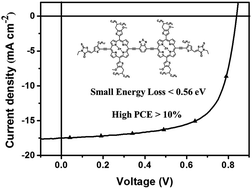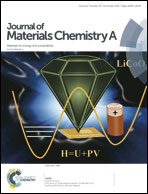A low-bandgap dimeric porphyrin molecule for 10% efficiency solar cells with small photon energy loss†
Abstract
Dimeric porphyrin molecules have great potential as donor materials for high performance bulk heterojunction organic solar cells (OSCs). Recently reported dimeric porphyrins bridged by ethynylenes showed power conversion efficiencies (PCEs) of more than 8%. In this study, we design and synthesize a new conjugated dimeric D–A porphyrin ZnP2BT-RH, in which the two porphyrin units are linked by an electron accepting benzothiadiazole (BT) unit. The introduction of the BT unit enhances the electron delocalization, resulting in a lower highest occupied molecular orbital (HOMO) energy level and an increased molar extinction coefficient in the near-infrared (NIR) region. The bulk heterojunction solar cells with ZnP2BT-RH as the donor material exhibit a high PCE of up to 10% with a low energy loss (Eloss) of only 0.56 eV. The 10% PCE is the highest for porphyrin-based OSCs with a conventional structure, and this Eloss is also the smallest among those reported for small molecule-based OSCs with a PCE higher than 10% to date.



 Please wait while we load your content...
Please wait while we load your content...